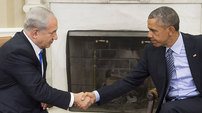20 sept 2016
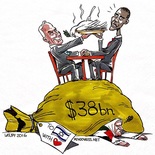
By Jonathan Cook
The announcement last week by the United States of the largest military aid package in its history – to Israel – was a win for both sides.
Israeli prime minister Benjamin Netanyahu could boast that his lobbying had boosted aid from $3.1 billion to $3.8bn a year – a 22 per cent increase – for a decade starting in 2019.
Netanyahu has presented this as a rebuff to those who accuse him of jeopardising Israeli security interests with his government’s repeated affronts to the White House.
In the past weeks alone, defence minister Avigdor Lieberman has compared last year’s nuclear deal between Washington and Iran with the 1938 Munich pact, which bolstered Hitler; and Netanyahu has implied that US opposition to settlement expansion is the same as support for the “ethnic cleansing” of Jews.
American president Barack Obama, meanwhile, hopes to stifle his own critics who insinuate that he is anti-Israel. The deal should serve as a fillip too for Hillary Clinton, the Democratic party’s candidate to succeed Obama in November’s election.
In reality, however, the Obama administration has quietly punished Netanyahu for his misbehaviour. Israeli expectations of a $4.5bn-a-year deal were whittled down after Netanyahu stalled negotiations last year as he sought to recruit Congress to his battle against the Iran deal.
In fact, Israel already receives roughly $3.8bn – if Congress’s assistance on developing missile defence programmes is factored in. Notably, Israel has been forced to promise not to approach Congress for extra funds.
Netanyahu’s agreement to such terms has incensed Israeli loyalists in Congress such as Republican Senator Lindsey Graham, who had been fighting Netanyahu’s corner to win an even larger aid handout from US taxpayers. He accused the Israeli prime minister on Friday of having “pulled the rug from under us”.
As Ehud Barak, Netanyahu’s former defence minister, also pointed out in a series of TV interviews in Israel, the deal fails to take into account either inflation or the dollar’s depreciation against the shekel.
A bigger blow still is the White House’s demand to phase out a special exemption that allowed Israel to spend nearly 40 per cent of aid locally on weapon and fuel purchases. Israel will soon have to buy all its armaments from the US, ending what amounted to a subsidy to its own arms industry.
Netanyahu preferred to sign the deal now rather than wait till the next president is installed, even though Clinton and her Republican challenger, Donald Trump, are expected to be even more craven towards Israel. That appears to reflect Netanyahu’s fear that the US political environment will be more uncertain after the election and could lead to long delays in an agreement, and apprehension about the implications for Israel of Trump’s general opposition to foreign aid.
Nonetheless, Washington’s renewed military largesse – in the face of almost continual insults – inevitably fuels claims that the Israeli tail is wagging the US dog. Even the New York Times has described the aid package as “too big”.
Since the 1973 war, Israel has received at least $100bn in military aid, with more assistance hidden from view. Back in the 1970s, Washington paid half of Israel’s military budget. Today it still foots a fifth of the bill, despite Israel’s economic success.
But the US expects a return on its massive investment. As the late Israeli politician-general Ariel Sharon once observed, Israel has been a US “aircraft carrier” in the Middle East, acting as the regional bully and carrying out operations that benefit Washington.
Almost no one implicates the US in Israeli attacks that wiped out Iraq and Syria’s nuclear programmes. A nuclear-armed Iraq or Syria, however, would have deterred later US-backed moves at regime overthrow, as well as countering the strategic advantage Israel derives from its own large nuclear arsenal.
In addition, Israel’s US-sponsored military prowess is a triple boon to the US weapons industry, the country’s most powerful lobby. Public funds are siphoned off to let Israel buy goodies from American arms makers. That, in turn, serves as a shop window for other customers and spurs an endless and lucrative game of catch-up in the rest of the Middle East.
The first F-35 fighter jets to arrive in Israel in December – their various components produced in 46 US states – will increase the clamour for the cutting-edge warplane.
Israel is also a “front-line laboratory”, as former Israeli army negotiator Eival Gilady admitted at the weekend, that develops and field-tests new technology Washington can later use itself.
The US is planning to buy back the missile interception system Iron Dome – which neutralises battlefield threats of retaliation – it largely paid for. Israel works closely too with the US in developing cyberwarfare, such as the Stuxnet worm that damaged Iran’s civilian nuclear programme.
But the clearest message from Israel’s new aid package is one delivered to the Palestinians: Washington sees no pressing strategic interest in ending the occupation. It stood up to Netanyahu over the Iran deal but will not risk a damaging clash with Israel and its loyalists in Congress over Palestinian statehood.
Some believe that Obama signed the aid agreement to win the credibility necessary to overcome his domestic Israel lobby and pull a rabbit from the hat: an initiative, unveiled shortly before he leaves office, that corners Netanyahu into making peace.
Hopes have been raised by an expected meeting at the United Nations in New York on Wednesday. But their first talks in 10 months are planned only to demonstrate the unity necessary to confound critics of the aid deal.
If Obama really wanted to pressure Netanyahu, he would have used the aid agreement as leverage. Now Netanyahu need not fear US financial retaliation, even as he intensifies effective annexation of the West Bank.
Netanyahu has drawn the right lesson from the aid deal – he can act again the Palestinians with continuing impunity and lots of US military hardware.
A version of this article first appeared in the National Abu Dhabi.
The announcement last week by the United States of the largest military aid package in its history – to Israel – was a win for both sides.
Israeli prime minister Benjamin Netanyahu could boast that his lobbying had boosted aid from $3.1 billion to $3.8bn a year – a 22 per cent increase – for a decade starting in 2019.
Netanyahu has presented this as a rebuff to those who accuse him of jeopardising Israeli security interests with his government’s repeated affronts to the White House.
In the past weeks alone, defence minister Avigdor Lieberman has compared last year’s nuclear deal between Washington and Iran with the 1938 Munich pact, which bolstered Hitler; and Netanyahu has implied that US opposition to settlement expansion is the same as support for the “ethnic cleansing” of Jews.
American president Barack Obama, meanwhile, hopes to stifle his own critics who insinuate that he is anti-Israel. The deal should serve as a fillip too for Hillary Clinton, the Democratic party’s candidate to succeed Obama in November’s election.
In reality, however, the Obama administration has quietly punished Netanyahu for his misbehaviour. Israeli expectations of a $4.5bn-a-year deal were whittled down after Netanyahu stalled negotiations last year as he sought to recruit Congress to his battle against the Iran deal.
In fact, Israel already receives roughly $3.8bn – if Congress’s assistance on developing missile defence programmes is factored in. Notably, Israel has been forced to promise not to approach Congress for extra funds.
Netanyahu’s agreement to such terms has incensed Israeli loyalists in Congress such as Republican Senator Lindsey Graham, who had been fighting Netanyahu’s corner to win an even larger aid handout from US taxpayers. He accused the Israeli prime minister on Friday of having “pulled the rug from under us”.
As Ehud Barak, Netanyahu’s former defence minister, also pointed out in a series of TV interviews in Israel, the deal fails to take into account either inflation or the dollar’s depreciation against the shekel.
A bigger blow still is the White House’s demand to phase out a special exemption that allowed Israel to spend nearly 40 per cent of aid locally on weapon and fuel purchases. Israel will soon have to buy all its armaments from the US, ending what amounted to a subsidy to its own arms industry.
Netanyahu preferred to sign the deal now rather than wait till the next president is installed, even though Clinton and her Republican challenger, Donald Trump, are expected to be even more craven towards Israel. That appears to reflect Netanyahu’s fear that the US political environment will be more uncertain after the election and could lead to long delays in an agreement, and apprehension about the implications for Israel of Trump’s general opposition to foreign aid.
Nonetheless, Washington’s renewed military largesse – in the face of almost continual insults – inevitably fuels claims that the Israeli tail is wagging the US dog. Even the New York Times has described the aid package as “too big”.
Since the 1973 war, Israel has received at least $100bn in military aid, with more assistance hidden from view. Back in the 1970s, Washington paid half of Israel’s military budget. Today it still foots a fifth of the bill, despite Israel’s economic success.
But the US expects a return on its massive investment. As the late Israeli politician-general Ariel Sharon once observed, Israel has been a US “aircraft carrier” in the Middle East, acting as the regional bully and carrying out operations that benefit Washington.
Almost no one implicates the US in Israeli attacks that wiped out Iraq and Syria’s nuclear programmes. A nuclear-armed Iraq or Syria, however, would have deterred later US-backed moves at regime overthrow, as well as countering the strategic advantage Israel derives from its own large nuclear arsenal.
In addition, Israel’s US-sponsored military prowess is a triple boon to the US weapons industry, the country’s most powerful lobby. Public funds are siphoned off to let Israel buy goodies from American arms makers. That, in turn, serves as a shop window for other customers and spurs an endless and lucrative game of catch-up in the rest of the Middle East.
The first F-35 fighter jets to arrive in Israel in December – their various components produced in 46 US states – will increase the clamour for the cutting-edge warplane.
Israel is also a “front-line laboratory”, as former Israeli army negotiator Eival Gilady admitted at the weekend, that develops and field-tests new technology Washington can later use itself.
The US is planning to buy back the missile interception system Iron Dome – which neutralises battlefield threats of retaliation – it largely paid for. Israel works closely too with the US in developing cyberwarfare, such as the Stuxnet worm that damaged Iran’s civilian nuclear programme.
But the clearest message from Israel’s new aid package is one delivered to the Palestinians: Washington sees no pressing strategic interest in ending the occupation. It stood up to Netanyahu over the Iran deal but will not risk a damaging clash with Israel and its loyalists in Congress over Palestinian statehood.
Some believe that Obama signed the aid agreement to win the credibility necessary to overcome his domestic Israel lobby and pull a rabbit from the hat: an initiative, unveiled shortly before he leaves office, that corners Netanyahu into making peace.
Hopes have been raised by an expected meeting at the United Nations in New York on Wednesday. But their first talks in 10 months are planned only to demonstrate the unity necessary to confound critics of the aid deal.
If Obama really wanted to pressure Netanyahu, he would have used the aid agreement as leverage. Now Netanyahu need not fear US financial retaliation, even as he intensifies effective annexation of the West Bank.
Netanyahu has drawn the right lesson from the aid deal – he can act again the Palestinians with continuing impunity and lots of US military hardware.
A version of this article first appeared in the National Abu Dhabi.
17 sept 2016
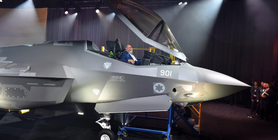
The deal guarantees Israel $10 million a day in U.S. military aid for the next decade. (Photo: Israeli Minister of Defence, Avigdor Lieberman)
The United States and Israel have agreed upon a new military aid package of $38 billion over 10 years.
A total of $5 billion are earmarked for Israel’s missile defense system, while the remaining $33 billion are for what the White House calls “military financing funds.”
The deal, called the Memorandum of Understanding (MoU) is the single largest pledge of military assistance to any country in U.S. history.
When the agreement comes into affect in 2018, each year for the next ten years, the U.S. will disperse $3.3 billion a year to Israel in foreign military financing, as well as another $500 million in missile defense funding.
Under the previous 10-year military aid agreement between the two, which expires in 2018, the U.S. provided Israel with $3 billion a year, or $8.5 million a day, in military funds. On top of funds from the previous 10-year agreement, the U.S. gave Israel an extra $3 billion in missile defense funding over the course of U.S. President Barak Obama’s time in office.
The new agreement will support the Israeli military and its illegal occupation to the tune of $10 million per day. The fact that this sum includes a budget for missile defense spending has led some to argue that it does not represent a significant increase in U.S. military aid to Israel.
According to a fact sheet released by the Office of the Press Secretary of the White House, the MoU “in practical terms” will update “the lion’s share” of Israel’s fighter aircraft fleet, “increase” its missile defense, and allow Israel to “acquire other defense capabilities.”
The agreement also includes emergency provisions allowing Israel to request additional military aid for wartime expenses.
Obama discussed the agreement in a statement released by the Office of the Press of the White House: “The new 10 year Memorandum of Understanding on security assistance… is just the most recent reflection of my steadfast commitment to the security of the State of Israel.”
Israeli Prime Minister Benjamin Netanyahu initially lobbied for receiving as much as $4.5 billion a year from the U.S. in military aid before agreeing to several small “concessions” — most of which scratch the back of the U.S. arms industry.
But, upon the agreement’s passing, Netanyahu ultimately “thanked” the U.S. for its support and told Israeli citizens that they “can be rightly proud of” the deal.
“Many in the U.S. understand that investment in the security of Israel strengthens the stability of the unstable Middle East and serves not only our security interests but those of the United States as well,” he added.
According to the new agreement, Israel must stop using 26.3% of U.S. military funding to buy Israeli arms. It must also stop directing 14% of U.S. funds to purchase fuel for its military.
These changes mean that Israel “will spend more funding, as much as $1.2 billion per year, on the advanced military capacities that only the United States can provide,” said the Office of the Press Secretary of the White House.
Congress must still formally approve the funding’s dispersal to Israel every year, but, it has done so enthusiastically, in the past. Israel is already the largest recipient of U.S. military aid, which regularly represents over 50% of all U.S. foreign military financing.
Yousef Munayyer, the executive director of the U.S. Campaign to End the Occupation, told the New York Times that, with this agreement, “we are helping the Israelis sustain the costs of occupation we claim is unsustainable.”
In a statement, Rebecca Vilkomerson, the executive director of Jewish Voices for Peace, said:
“The United States is once again committing to a decade of increased military aid to Israel, despite that country’s deplorable human rights record. The main beneficiaries of this unprecedented amount of aid will be not just the Israeli military, but also the U.S. arms industry… increasing the military aid package is rewarding destructive Israeli behavior that violates longstanding official U.S. policy and international law.
As a result, the U.S. is effectively underwriting Israel’s occupation and apartheid policies towards the Palestinians.”
The United States and Israel have agreed upon a new military aid package of $38 billion over 10 years.
A total of $5 billion are earmarked for Israel’s missile defense system, while the remaining $33 billion are for what the White House calls “military financing funds.”
The deal, called the Memorandum of Understanding (MoU) is the single largest pledge of military assistance to any country in U.S. history.
When the agreement comes into affect in 2018, each year for the next ten years, the U.S. will disperse $3.3 billion a year to Israel in foreign military financing, as well as another $500 million in missile defense funding.
Under the previous 10-year military aid agreement between the two, which expires in 2018, the U.S. provided Israel with $3 billion a year, or $8.5 million a day, in military funds. On top of funds from the previous 10-year agreement, the U.S. gave Israel an extra $3 billion in missile defense funding over the course of U.S. President Barak Obama’s time in office.
The new agreement will support the Israeli military and its illegal occupation to the tune of $10 million per day. The fact that this sum includes a budget for missile defense spending has led some to argue that it does not represent a significant increase in U.S. military aid to Israel.
According to a fact sheet released by the Office of the Press Secretary of the White House, the MoU “in practical terms” will update “the lion’s share” of Israel’s fighter aircraft fleet, “increase” its missile defense, and allow Israel to “acquire other defense capabilities.”
The agreement also includes emergency provisions allowing Israel to request additional military aid for wartime expenses.
Obama discussed the agreement in a statement released by the Office of the Press of the White House: “The new 10 year Memorandum of Understanding on security assistance… is just the most recent reflection of my steadfast commitment to the security of the State of Israel.”
Israeli Prime Minister Benjamin Netanyahu initially lobbied for receiving as much as $4.5 billion a year from the U.S. in military aid before agreeing to several small “concessions” — most of which scratch the back of the U.S. arms industry.
But, upon the agreement’s passing, Netanyahu ultimately “thanked” the U.S. for its support and told Israeli citizens that they “can be rightly proud of” the deal.
“Many in the U.S. understand that investment in the security of Israel strengthens the stability of the unstable Middle East and serves not only our security interests but those of the United States as well,” he added.
According to the new agreement, Israel must stop using 26.3% of U.S. military funding to buy Israeli arms. It must also stop directing 14% of U.S. funds to purchase fuel for its military.
These changes mean that Israel “will spend more funding, as much as $1.2 billion per year, on the advanced military capacities that only the United States can provide,” said the Office of the Press Secretary of the White House.
Congress must still formally approve the funding’s dispersal to Israel every year, but, it has done so enthusiastically, in the past. Israel is already the largest recipient of U.S. military aid, which regularly represents over 50% of all U.S. foreign military financing.
Yousef Munayyer, the executive director of the U.S. Campaign to End the Occupation, told the New York Times that, with this agreement, “we are helping the Israelis sustain the costs of occupation we claim is unsustainable.”
In a statement, Rebecca Vilkomerson, the executive director of Jewish Voices for Peace, said:
“The United States is once again committing to a decade of increased military aid to Israel, despite that country’s deplorable human rights record. The main beneficiaries of this unprecedented amount of aid will be not just the Israeli military, but also the U.S. arms industry… increasing the military aid package is rewarding destructive Israeli behavior that violates longstanding official U.S. policy and international law.
As a result, the U.S. is effectively underwriting Israel’s occupation and apartheid policies towards the Palestinians.”
16 sept 2016

Israeli soldiers invaded, on Friday evening, the town of Beit Ummar, north of the southern West Bank city of Hebron, fired many gas bombs, including a new type of smokeless bombs, and rubber-coated steel bullets, wounding many Palestinians, and kidnapped a teenager.
Mohammad Awad, the media coordinator of the Popular Committee in Beit Ummar, said the soldiers invaded the center of the town, and closed the Baq’a street with their military vehicles, preventing the residents from crossing.
The soldiers harassed and questioned many Palestinians, and conducted provocative acts that led to clashes between many locals, who hurled stones at the military vehicles, and the soldiers who fired gas bombs and rubber-coated steel bullets.
Awad said the soldiers used a new type of gas bombs that do no produce smoke, but a strong smell that causes the people to choke, and faint.
Medics rushed to the town and provided the wounded Palestinians with the needed medical treatment, and the soldiers kidnapped a teenager, identified as Anan Adel Abu Ayyash, 17.
Mohammad Awad, the media coordinator of the Popular Committee in Beit Ummar, said the soldiers invaded the center of the town, and closed the Baq’a street with their military vehicles, preventing the residents from crossing.
The soldiers harassed and questioned many Palestinians, and conducted provocative acts that led to clashes between many locals, who hurled stones at the military vehicles, and the soldiers who fired gas bombs and rubber-coated steel bullets.
Awad said the soldiers used a new type of gas bombs that do no produce smoke, but a strong smell that causes the people to choke, and faint.
Medics rushed to the town and provided the wounded Palestinians with the needed medical treatment, and the soldiers kidnapped a teenager, identified as Anan Adel Abu Ayyash, 17.
13 sept 2016
National Security Council Acting Chairman Yaakov Nagal, arrived Tuesday morning to Washington to sign a Memorandum of Understanding (MOU) which will complete the military aid package from the US to Israel that will be valid until 2029.
According to the prospective agreement, which will go into effect upon the expiration of the current package in 2018, the US will provide Israel with a financial package which will amount to $38 billion over the course of the next decade along with missile defense systems. Under the terms of the agreement, Israel will also be prohibited from making additional budgetary requests from Congress.
The current military aid package, which will expire in 2018, provided Israel with an annual sum of $3.1 billion. Prime Minister Netanyahu requested a significant increase of $4.5 billion per year on account of his unsuccessful bid to stymie the US-Iran nuclear agreement. However, the two sides eventually reached a middle ground, resulting in an annual financial sum of $3.8 billion.
The new package will include provisions, for the first time, for missile defense projects which, hitherto, have been drawn from funds directly from Congress. Indeed, over the last few years, American legislators transferred up to $600 million for missile defense purposes.
According to the prospective agreement, which will go into effect upon the expiration of the current package in 2018, the US will provide Israel with a financial package which will amount to $38 billion over the course of the next decade along with missile defense systems. Under the terms of the agreement, Israel will also be prohibited from making additional budgetary requests from Congress.
The current military aid package, which will expire in 2018, provided Israel with an annual sum of $3.1 billion. Prime Minister Netanyahu requested a significant increase of $4.5 billion per year on account of his unsuccessful bid to stymie the US-Iran nuclear agreement. However, the two sides eventually reached a middle ground, resulting in an annual financial sum of $3.8 billion.
The new package will include provisions, for the first time, for missile defense projects which, hitherto, have been drawn from funds directly from Congress. Indeed, over the last few years, American legislators transferred up to $600 million for missile defense purposes.
12 sept 2016
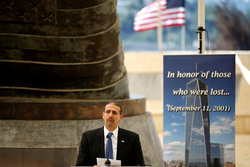
US Ambassador Shapiro speaks at 9/11 memorial ceremony
Speaking at a 9/11 memorial and opening the Institute for Counterterrorism's 16th World Summit, US Ambassador Dan Shapiro says that a US aid package shows commitment to Israeli qualitative military edge in the region.
US Ambassador to Israel Dan Shapiro said that the US will be signing its largest ever aid package to Israel, and that the aid package will cover all of Israel's security needs until 2029.
He was speaking at the opening of the 16th World Summit of the International Institute for Counter Terrorism at the Herzeliya Interdisciplinary Center (IDC) on Sunday.
"The next decade of American military support for Israel is spelled out in a Memorandum of Understanding our countries have been discussing in recent months. “The new agreement with Israel will guide our military assistance until 2029,” National Security Advisor Susan Rice told the American Jewish Committee a few months ago, “and will be the single largest military assistance package—with any country—in American history,” the Ambassador said in his speech.
He went on to describe that the US will continue to help Israel maintain its qualitative edge in the region by providing the Jewish state with next generation fighter jets, helping to finance anti-missile technology, and investing in tunnel detection technology.
According to the Washington Post, the White House is delaying the signing of the agreement due to a conflict with the US Senate, chief amongst them South Carolina Senator Lindsey Graham (R).
Graham is leading the fight in Congress to increase the amount of US aid to Israel to $3.4 billion.
Graham was quoted as saying “the Israeli prime minister told me the administration is refusing to sign the (memorandum of understanding) until I agree to change my appropriation markup back to $3.1 billion,” Graham said. “I said, ‘Tell the administration to go F themselves.’
“I’m offended that the administration would try to take over the appropriations process," Graham said. "If they don’t like what I’m doing, they can veto the bill. We can’t have the executive branch dictating what the legislative branch will do for a decade based on an agreement we are not a party to.”
Speaking at a 9/11 memorial and opening the Institute for Counterterrorism's 16th World Summit, US Ambassador Dan Shapiro says that a US aid package shows commitment to Israeli qualitative military edge in the region.
US Ambassador to Israel Dan Shapiro said that the US will be signing its largest ever aid package to Israel, and that the aid package will cover all of Israel's security needs until 2029.
He was speaking at the opening of the 16th World Summit of the International Institute for Counter Terrorism at the Herzeliya Interdisciplinary Center (IDC) on Sunday.
"The next decade of American military support for Israel is spelled out in a Memorandum of Understanding our countries have been discussing in recent months. “The new agreement with Israel will guide our military assistance until 2029,” National Security Advisor Susan Rice told the American Jewish Committee a few months ago, “and will be the single largest military assistance package—with any country—in American history,” the Ambassador said in his speech.
He went on to describe that the US will continue to help Israel maintain its qualitative edge in the region by providing the Jewish state with next generation fighter jets, helping to finance anti-missile technology, and investing in tunnel detection technology.
According to the Washington Post, the White House is delaying the signing of the agreement due to a conflict with the US Senate, chief amongst them South Carolina Senator Lindsey Graham (R).
Graham is leading the fight in Congress to increase the amount of US aid to Israel to $3.4 billion.
Graham was quoted as saying “the Israeli prime minister told me the administration is refusing to sign the (memorandum of understanding) until I agree to change my appropriation markup back to $3.1 billion,” Graham said. “I said, ‘Tell the administration to go F themselves.’
“I’m offended that the administration would try to take over the appropriations process," Graham said. "If they don’t like what I’m doing, they can veto the bill. We can’t have the executive branch dictating what the legislative branch will do for a decade based on an agreement we are not a party to.”
8 sept 2016

Photo: The Israeli military’s new unmanned ground vehicle is self-driving and will be fitted with a machine gun.
FoxNews.com reported that the Israeli military has equipped Ford F-350 pickup trucks with remote driving technology and plans to disperse them along the border of the besieged Gaza Strip.
The trucks, called Border Protector Unmanned Ground Vehicles (UGVs), are each equipped with a 360-degree surveillance camera as well as four cameras that supplant a driver’s eyes on the road.
G-NIUS – a joint venture between Israel Aerospace Industries (IAI) and Elbit Systems that enjoys funding by the Israeli defense ministry – developed the “Border Protector” specifically for Gaza. Testing began in July 2015 and ended in February 2016.
The Israeli military plans to deploy the new UGVs semi-autonomously in the next few months. It will release them along Gaza’s border with complete autonomy soon thereafter.
An official in the Israeli military explained to FoxNews.com, “we think at the beginning of next year we will get a machine gun on the vehicle that will be operated from a control room.” “The machine gun will not be autonomous,” the official clarified.
FoxNews.com reported that the Israeli military has equipped Ford F-350 pickup trucks with remote driving technology and plans to disperse them along the border of the besieged Gaza Strip.
The trucks, called Border Protector Unmanned Ground Vehicles (UGVs), are each equipped with a 360-degree surveillance camera as well as four cameras that supplant a driver’s eyes on the road.
G-NIUS – a joint venture between Israel Aerospace Industries (IAI) and Elbit Systems that enjoys funding by the Israeli defense ministry – developed the “Border Protector” specifically for Gaza. Testing began in July 2015 and ended in February 2016.
The Israeli military plans to deploy the new UGVs semi-autonomously in the next few months. It will release them along Gaza’s border with complete autonomy soon thereafter.
An official in the Israeli military explained to FoxNews.com, “we think at the beginning of next year we will get a machine gun on the vehicle that will be operated from a control room.” “The machine gun will not be autonomous,” the official clarified.
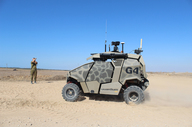
The Israeli military has used the Guardium unmanned ground vehicle along Gaza’s besieged border since at least 2009. Photo by the Israeli military, September 2012.
The Israeli military has been using driverless vehicles to blockade the coastal enclave for years; its last model, the Guardium UGV has patrolled Gaza’s border since at least 2009.
However, Israeli soldiers remotely controlled “the Gardium.” The new UGV, on the other hand, has the capacity to embark on a mission completely on its own after receiving directions from an Israeli soldier.
The State of Israel established a so-called buffer zone [PDF] around Gaza after it withdrew from the area in 2005.
According to the Palestinian Center for Human Rights, as a consequence of the buffer zone, 35% of Gaza’s agricultural land can only be accessed under high risk of death or injury.
Though Gaza’s border continues to undergo increasing militarization, IAI and Elbit Systems have decided to dissolve G-NIUS, citing a lack of international buyers. In announcing the break up, both parties, however, maintained their commitment to developing autonomous military technology.
The Israeli military has been using driverless vehicles to blockade the coastal enclave for years; its last model, the Guardium UGV has patrolled Gaza’s border since at least 2009.
However, Israeli soldiers remotely controlled “the Gardium.” The new UGV, on the other hand, has the capacity to embark on a mission completely on its own after receiving directions from an Israeli soldier.
The State of Israel established a so-called buffer zone [PDF] around Gaza after it withdrew from the area in 2005.
According to the Palestinian Center for Human Rights, as a consequence of the buffer zone, 35% of Gaza’s agricultural land can only be accessed under high risk of death or injury.
Though Gaza’s border continues to undergo increasing militarization, IAI and Elbit Systems have decided to dissolve G-NIUS, citing a lack of international buyers. In announcing the break up, both parties, however, maintained their commitment to developing autonomous military technology.
